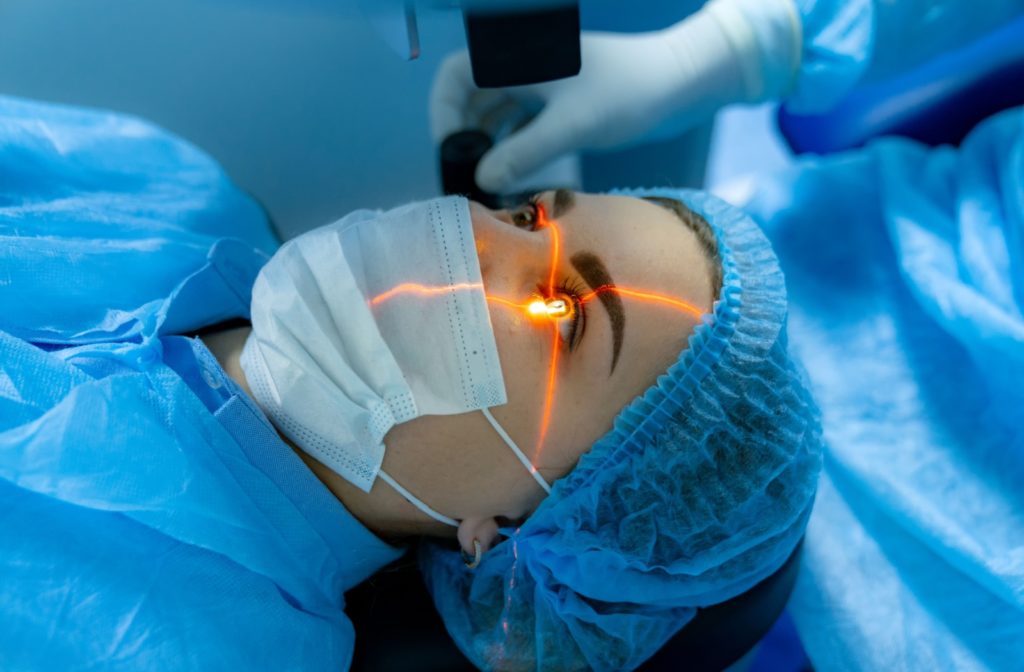Blurry vision caused by astigmatism can impact your daily life, though glasses or contact lenses are simple ways to help you see clearly. If you want a more permanent solution, or if your prescription starts to worsen, LASIK can be an option for those with mild-to-moderate astigmatism.
While a consultation with your optometrist is needed to determine if LASIK is right for you, first you have to consider whether LASIK is an option you’d like to pursue.
Is My Astigmatism a Good Fit for LASIK?
Astigmatism is a common vision problem caused by an irregularly shaped cornea or lens, but not all forms of astigmatism are created equal. Generally, LASIK is most effective for mild to moderate astigmatism. If your astigmatism falls within this range, LASIK could potentially offer you a significant improvement in vision.
Your candidacy for LASIK will also depend on other factors such as:
- Overall eye health
- Corneal thickness
- Moisture content
- Overall health status
- Your goals for vision correction
It’s important to remember that LASIK is a surgical procedure that involves risks, just like any medical procedure. LASIK pros often include long-lasting results, improved vision, and minimal downtime, while LASIK cons can include cost, potential side effects (including dry eyes, blurry vision, infection, etc.), the possibility of an unsuccessful surgery, and the eventual need for additional vision correction.
By understanding the pros and cons, you can make a more informed decision about whether LASIK is the right choice for treating your astigmatism.
How Effective is LASIK In Treating Astigmatism?
LASIK – Laser-Assisted In Situ Keratomileusis – reshapes the cornea to correct refractive errors like astigmatism. The process involves creating a thin flap in the cornea, which is then lifted to allow a laser to reshape the underlying corneal tissue.
This advanced technology has been refined over decades, making it a safe and effective option for many patients. The entire procedure typically takes less than 30 minutes, and both eyes can be treated on the same day.
Success Rate of LASIK for Astigmatism
LASIK has a high success rate for correcting astigmatism, with many patients achieving 20/20 vision or better. According to various studies, approximately 95% of individuals who undergo LASIK for astigmatism are satisfied with their results.
While the satisfaction rate is impressive, the degree of vision improvement can vary based on the severity of your astigmatism and other individual factors. Some people may still need to wear glasses or contact lenses for specific tasks, such as reading or driving at night.
Will I Still Have Astigmatism after LASIK?
LASIK may not completely eliminate astigmatism in every case. Residual astigmatism can occur, especially in cases where the initial astigmatism is severe. In such instances, additional treatments or enhancements may be necessary to achieve the desired level of vision correction.
What Does the LASIK Procedure Look Like?
Understanding the LASIK procedure can help alleviate any concerns you may have if you decide to pursue LASIK and your optometrist considers you a good candidate.
Pre-Procedure
Before the procedure, you’ll undergo a comprehensive eye exam to determine your candidacy for LASIK. This includes measurements of your corneal thickness, vision stability, vision problems and risk factors. You’ll also discuss your medical history and any specific concerns you may have.
During the Procedure
On the day of the procedure, numbing eye drops will be applied to ensure your comfort. You’ll be positioned under the laser, and a device will be used to keep your eye open and steady. The surgeon will create a thin flap on the cornea using a microkeratome or femtosecond laser.
Once the flap is lifted, the laser will be used to reshape the cornea. You’ll be asked to focus on a target light while the laser does its work. The flap is then repositioned, and the procedure is complete.
You will be awake throughout the procedure and can communicate with your surgeon if needed. The entire process typically takes about 10-15 minutes per eye, making it a convenient option for those with busy schedules.
Post-Procedure
After the procedure, you’ll rest for a short period before going home. It’s important to have someone drive you, as your vision may be temporarily blurry. You’ll receive post-operative instructions and eye drops to aid healing and prevent infection.
Recovery from LASIK is generally swift, but it’s important to follow your surgeon’s post-operative care instructions even as you start to feel better. This includes using prescribed eye drops, avoiding rubbing your eyes, and protecting your eyes from irritants.

Options for Astigmatism Besides LASIK
While LASIK is a popular and effective option for treating astigmatism, it’s not the only choice available. Some alternatives include:
- Glasses and Contact Lenses
- Toric Intraocular Lenses (IOLs): For anyone undergoing cataract surgery, toric IOLs can be implanted during surgery to correct astigmatism along with cataracts
- Other Refractive Surgeries: Procedures such as PRK (Photorefractive Keratectomy) and SMILE (Small Incision Lenticule Extraction) are viable alternatives to LASIK
Exploring all available options ensures that you find the best solution for your lifestyle. Even if you’re not sold on having LASIK right now, having a conversation with your optometrist can give you more information.
Total Vision Lake Elsinore is proud to offer laser eye surgery consultation in San Clemente. Contact us today to learn more about how to deal with astigmatism or see if you’re a good candidate for LASIK.



